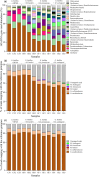Effect of model methanogens on the electrochemical activity, stability, and microbial community structure of Geobacter spp. dominated biofilm anodes
- PMID: 38443373
- PMCID: PMC10915144
- DOI: 10.1038/s41522-024-00490-z
Effect of model methanogens on the electrochemical activity, stability, and microbial community structure of Geobacter spp. dominated biofilm anodes
Erratum in
-
Author Correction: Effect of model methanogens on the electrochemical activity, stability, and microbial community structure of Geobacter spp. dominated biofilm anodes.NPJ Biofilms Microbiomes. 2024 Apr 12;10(1):41. doi: 10.1038/s41522-024-00513-9. NPJ Biofilms Microbiomes. 2024. PMID: 38609420 Free PMC article. No abstract available.
Abstract
Combining anaerobic digestion (AD) and microbial electrochemical technologies (MET) in AD-MET holds great potential. Methanogens have been identified as one cause of decreased electrochemical activity and deterioration of Geobacter spp. biofilm anodes. A better understanding of the different interactions between methanogenic genera/species and Geobacter spp. biofilms is needed to shed light on the observed reduction in electrochemical activity and stability of Geobacter spp. dominated biofilms as well as observed changes in microbial communities of AD-MET. Here, we have analyzed electrochemical parameters and changes in the microbial community of Geobacter spp. biofilm anodes when exposed to three representative methanogens with different metabolic pathways, i.e., Methanosarcina barkeri, Methanobacterium formicicum, and Methanothrix soehngenii. M. barkeri negatively affected the performance and stability of Geobacter spp. biofilm anodes only in the initial batches. In contrast, M. formicicum did not affect the stability of Geobacter spp. biofilm anodes but caused a decrease in maximum current density of ~37%. M. soehngenii induced a coloration change of Geobacter spp. biofilm anodes and a decrease in the total transferred charge by ~40%. Characterization of biofilm samples after each experiment by 16S rRNA metabarcoding, whole metagenome nanopore sequencing, and shotgun sequencing showed a higher relative abundance of Geobacter spp. after exposure to M. barkeri as opposed to M. formicicum or M. soehngenii, despite the massive biofilm dispersal observed during initial exposure to M. barkeri.
© 2024. The Author(s).
Conflict of interest statement
The authors declare no competing interests.
Figures




Similar articles
-
Combining Geobacter spp. Dominated Biofilms and Anaerobic Digestion Effluents─The Effect of Effluent Composition and Electrode Potential on Biofilm Activity and Stability.Environ Sci Technol. 2023 Feb 14;57(6):2584-2594. doi: 10.1021/acs.est.2c07574. Epub 2023 Feb 2. Environ Sci Technol. 2023. PMID: 36731122
-
A unified and simple medium for growing model methanogens.Front Microbiol. 2023 Jan 10;13:1046260. doi: 10.3389/fmicb.2022.1046260. eCollection 2022. Front Microbiol. 2023. PMID: 36704566 Free PMC article.
-
Benefits of Age-Improved Resistance of Mature Electroactive Biofilm Anodes in Anaerobic Digestion.Environ Sci Technol. 2021 Jun 15;55(12):8258-8266. doi: 10.1021/acs.est.0c07320. Epub 2021 Jun 7. Environ Sci Technol. 2021. PMID: 34096274
-
Biofilm Biology and Engineering of Geobacter and Shewanella spp. for Energy Applications.Front Bioeng Biotechnol. 2021 Dec 3;9:786416. doi: 10.3389/fbioe.2021.786416. eCollection 2021. Front Bioeng Biotechnol. 2021. PMID: 34926431 Free PMC article. Review.
-
Electrokinetic analyses in biofilm anodes: Ohmic conduction of extracellular electron transfer.Bioresour Technol. 2018 May;256:509-514. doi: 10.1016/j.biortech.2018.02.002. Epub 2018 Feb 23. Bioresour Technol. 2018. PMID: 29478785 Review.
Cited by
-
Detecting Excess Biofilm Thickness in Microbial Electrolysis Cells by Real-Time In-Situ Biofilm Monitoring.Biotechnol Bioeng. 2025 Aug;122(8):2049-2062. doi: 10.1002/bit.29017. Epub 2025 May 2. Biotechnol Bioeng. 2025. PMID: 40317484 Free PMC article.
References
-
- Korth B, Maskow T, Picioreanu C, Harnisch F. The microbial electrochemical Peltier heat. An energetic burden and engineering chance for primary microbial electrochemical technologies. Energy Environ. Sci. 2016;9:2539–2544. doi: 10.1039/C6EE01428C. - DOI
MeSH terms
Substances
Grants and funding
LinkOut - more resources
Full Text Sources
Molecular Biology Databases
Miscellaneous

